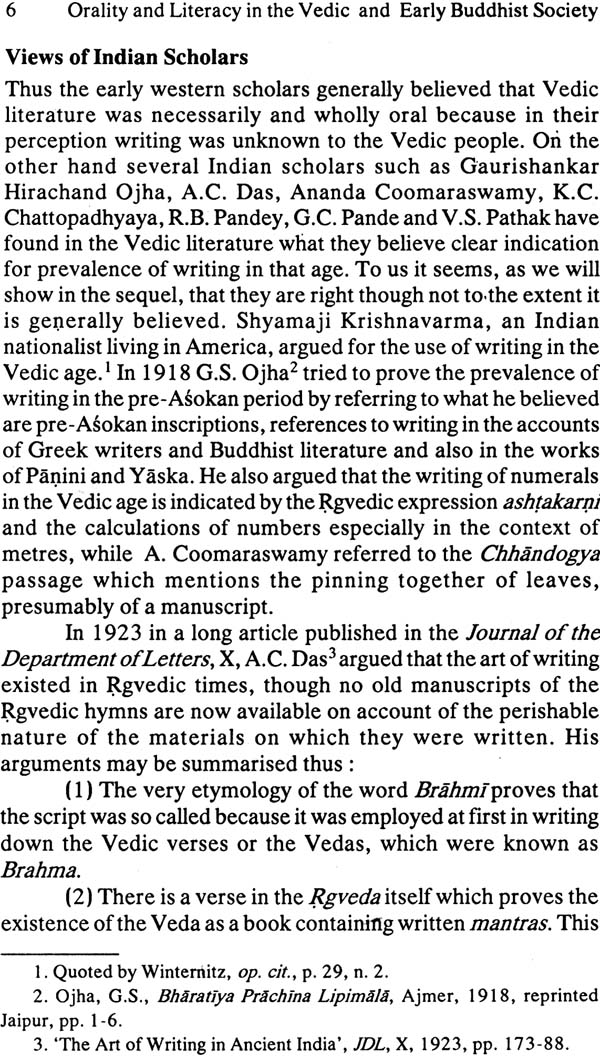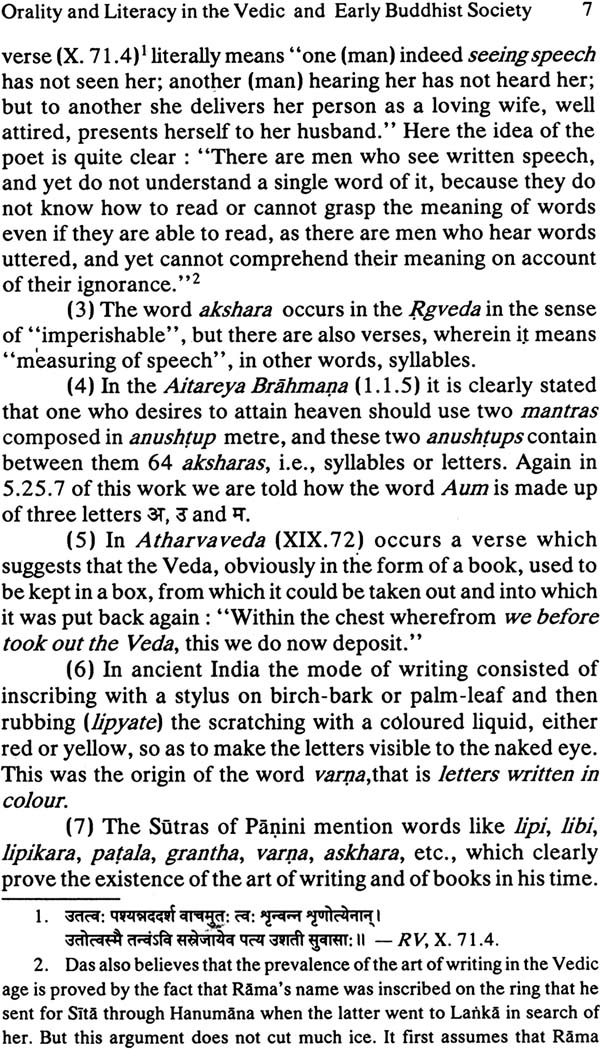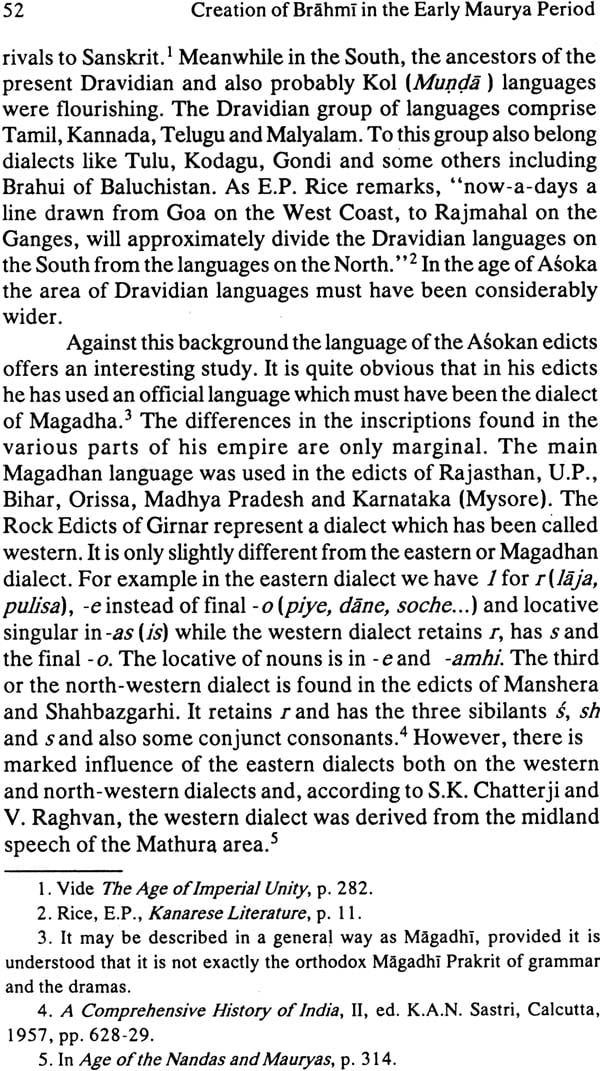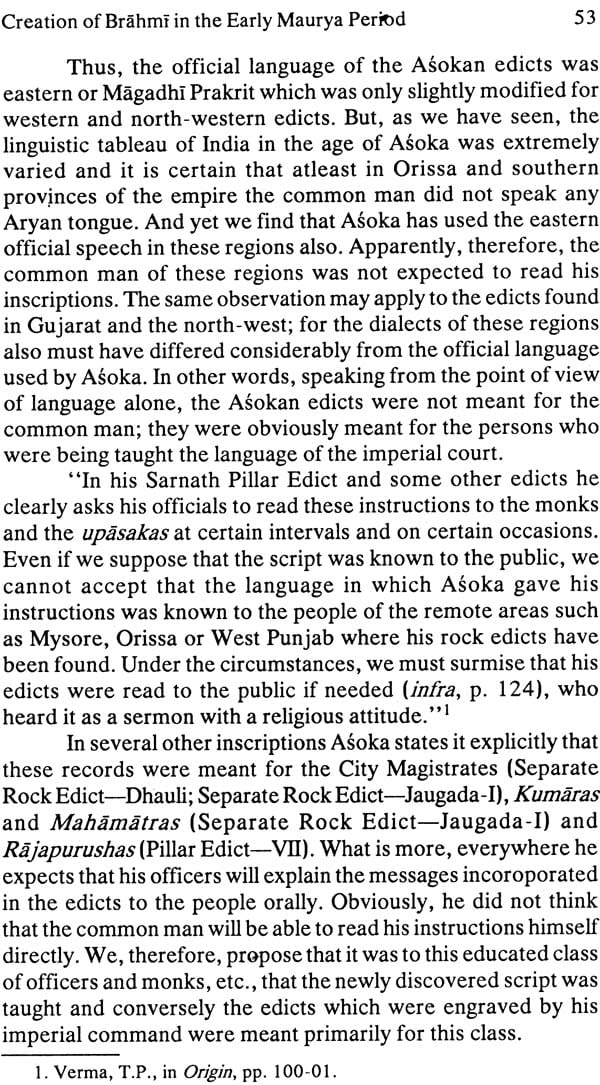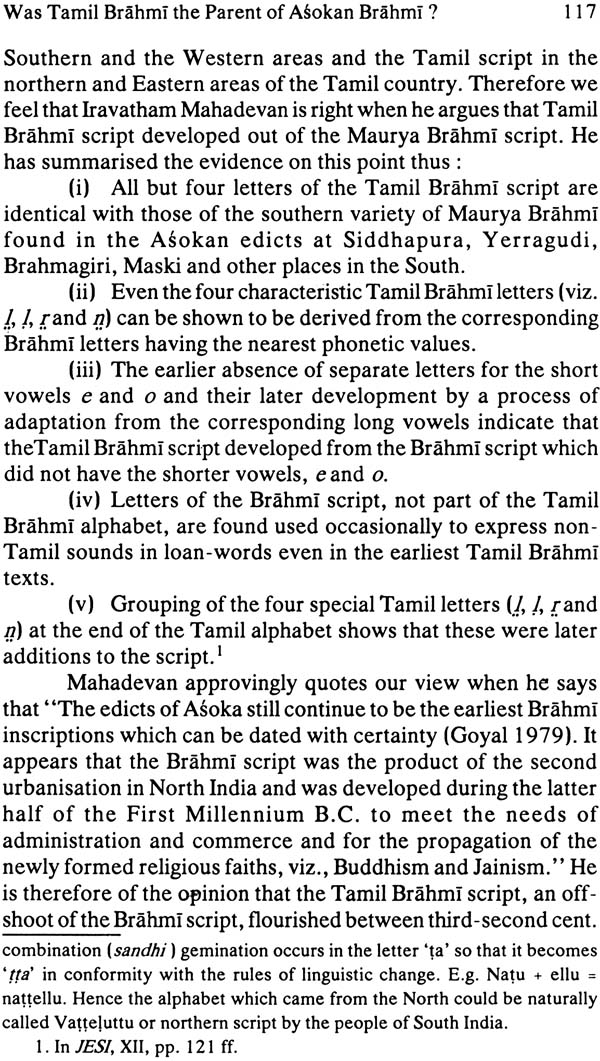
Brahmi Script (An Invention of the Early Maurya Period)
Book Specification
| Item Code: | NAM550 |
| Author: | S. R. Goyal |
| Publisher: | Kusumanjali Book World, Jodhpur |
| Language: | English |
| Edition: | 2006 |
| Pages: | 170 |
| Cover: | Hardcover |
| Other Details | 8.5 inch X 5.5 inch |
| Weight | 380 gm |
Book Description
Professor S.R. Goyal is the retired Professor and Head, Department of History, J.N.V. University, Jodhpur. Described as one of the five best recent historians of ancient India by Professor David N. Lorenzen, the great Mexican Orientalist, and Professor Goyal combines in himself all the qualities associated with scientific scholarship. He has authored about forty voluminous research works and over 150 research papers which cover so diverse fields as political history, religious history, literature, biographies, numismatics and epigraphy.
To the epigraphical studies Professor Goyal's contribution has been extremely significant and valuable. Apart from numerous research papers on epigraphical problems he has also produced three 'Corpus- like' volumes on ancient Indian inscriptions (viz. Prachina Bharatiya Abhilekha Samgraha-Prak-Guptayugina, Guptakslina Abhilekha and Maukhari-Pusbyabhuti Chalukyayugina Abhilekha) which have been highly acclaimed by epigraphists throughout the country. His research paper on the problem of the origin of Brahrnt was published as a lead- paper in The Origin of Brsbmi Script, edited by S.P. Gupta and K.S. Ramachandran, on which numerous epigraphists, palaeographists and historians wrote their reaction papers.
Similarly, his paper on the identification of King Chandra of the Meharauli prasasti become the nucleus of another monograph to which over two dozen scholars contributed their reaction papers (King Chandra and the Meharauli Pillar, ed. by Munish Chandra Joshi, Former Director-General, Archaeological Survey, Government of India).
Professor Goyal was honoured with the General President Ship of the Silver Jubilee Congress of the Epigraphical Society of India held at Udupi in 1999 and was elected the Honorary Fellow of the Society. He also presided over the National Seminar on the Methods of Epigraphical Studies and History Writing held at Vikram University, Ujjain, in 2001.
Professor Goyal has been honoured with several Festschrifts, including Reappraising Gupta History for S.R. Goyal (ed. by Professor B.Ch. Chhabra et al), S.R. Goyal: His Multidimensional Historiography (ed. by Professor Jagannath Agrawal and Dr. Shankar Goyal) and Rajasthan Bharati, in two volumes (ed. by Drs. Sobhag Mathur and Shankar Goyal). A four-volume Festschrift in about two thousand pages in his honour entitled Sriramabhinandanam (Reconstructing Indian History for S.R. Goyal) has also been published recently.
The Story of My Dabblings into the Problems of the Antiquity of the Art of Writing in India and the Origin of Brahmi Script Writing has been termed the most momentous invention human beings have ever made. When we speak we utter sounds in one or other language using a series of sound sequences that carry specific meanings in that language. What writing does is to encode in visual form, through a set of distinct symbols or signs, those sounds and sound sequences-thereby conveying some meaning or information. Both these things-uttering sounds in a series of sequences and then encoding those sounds in visual forms through a set of distinct signs or symbols cannot be done by other members of the animal world. Before the widespread use of writing, knowledge and culture were passed on to the next generation by parents, teachers and other member of the community. Writing made possible the transmission and storage of information and the maintenance of records for future reference. It also made communication at a distance possible. It requires of the writer knowledge of the signs and some amount of manual dexterity, and of the reader, knowledge of how the visual signs are vocalized and, of course, familiarity with the relevant language.
The various civilized races of the world in course of their history used different scripts which they either evolved themselves or borrowed from other nations. The people of the Indian sub-continent have had various sorts of experience in this regard. In the age of the Indus civilization they evolved their own script which is yet to be deciphered. Then they seem to have remained without a script of their own in the Vedic age and then, finally, invented a new script called Brahmt which became the vehicle of communication throughout South Asia.
The first inscriptions written in the Brahmi script belong to the age of Asoka, But whether or not this script existed before his time and how did it come into existence are questions which have attracted the attention of scholars since the beginning of Asokan epigraphy and have not been finally answered as yet.
I myself began to study the Maurya Brahmi script when I was a Post-Graduate student of the Department of History of Allahabad University in the mid-fiftees of the last century. By that time the days of the glory of 'the Allahabad School of History', the appellation which the historians of Allahabad informally enjoyed, were not yet over and the University was famous as a great centre of historical studies.
At that time two major theories regarding the origin of Brahmi were prevalent in India-according to one (which was popular mostly with the Western and a few Indian scholars) it originated due to the impact of some West Asiatic Semitic script and according to another (which was advocated mostly by Indians and a few European scholars) it developed indigenously, most probably out of the script of the hitherto undeciphered Indus civilization. Our teachers at Allahabad mutatis mutandis preferred the latter theory partly because at that time the Indian Indological world was still passing through the phase of nationalist historiography but more so because this theory was considered more logical and in better tune with the literary evidence. Further, at that time the impact of Pt. K.C. Chattopadhyaya of Sanskrit Department, a great Vedic scholar and my paramaguru, was supreme in the circle of Allahabad historians and our teachers including Professors G.C. Pande (who had great affection for me) and G. R. Sharma (who taught us Palaeography) were under the spell of Pandit ji's rshikalpa personality and scholarship. As Pandit ji had discovered references to the art of writing even in the Rgveda, all of us-teachers and students alike-believed in the indigenous origin of Brahmri.
I completed post-graduation in 1955 and then, after a brief teaching period (1955-58) in a college of Allahabad University, joined the Department of Ancient History, Culture and Archaeology of the University of Gorakhpur which was at first headed by Professor G.C. Pande and then sometime afterwards by Professor V.S. Pathak. Pathakji, who had been a student of Professor A.L. Basham, obliged me by becoming my research supervisor. He was also a great Indologist. He also believed that Brahmi was known and practised by the Rgvedic Aryans. Therefore, a close contact with him tended to strengthen y belief, imbibed at Allahabad, in the high antiquity of Brahmi.
Such was my psychological make up as regard the problem of the origin of Brahmt when I joined the University of Jodhpur as Reader in History in 1970.As the History Department of Jodhpur was a composite one (teaching the history of all the periods of Indian history and also of Europe and modern world etc.), only a few papers on ancient Indian history, mostly political, were included in its syllabus. Therefore, when I requested for and was given the charge of reorganising the teaching of Ancient India Group', I introduced the paper of Palaeography, Epigraphy and Numismatics also, not taught earlier. As the responsibility of teaching this paper fell upon me it was but natural that as regards the problem of the origin of Brahmi. I taught my students what I had learnt at Allahabad and Gorakhpur (viz. that the Brahmt script originated in the Vedic age).
But soon something happened. One day, rather one midnight, when I was lying half awake it occurred to me all of a sudden as a flash of lightning that the total absence of written documents after the end of the Indus civilization in c. 1500 B.C. till the age of Asoka (middle of the third century B.C.), that is for more than a thousand years, is in perfect consonance with the testimony of Megasthenes who has deposed that when he visited India in c. 300 B.C. Indians did not know the art of writing. I at once realized that these two lines of evidence taken together conclusively establish that art of writing, in this case the Brahmi script, was invented sometime after 300 B.C. but before the edicts of Asoka were engraved (c. 260 B.C.). This conclusion was startling, almost revolutionary, and altogether against the universally accepted view that the history of the art of writing in India commenced sometime in the Vedic age.
Contents
| Introduction | VII | |
| Detailed Synopsis of Chapters | XVII | |
| List of Illustrations | XXI | |
| Abbreviations | XXIII | |
| The Problem | 1-2 | |
| 1 | Orality and Literacy in the Vedic and Early Buddhist Society | 3-32 |
| 2 | Creation of Brahmi in the Early Maurya Period | 33-53 |
| 3 | Megasthenes on the Absence of the Art of Writing in India | 54-68 |
| 4 | Absence of Regional Variations in the Asokan Brahmi and Its Implications | 69-72 |
| 5 | Nature of Brahmi and role of Sanskrit Grammar in Its Creation | 73-86 |
| 6 | Supposed Connection of Indus and Brahmi Scripts and Graffiti Marks | 87-94 |
| 7 | Supposedly Pre- Ashokan Brahmi Coin - Legends and Epigraphs | 95-112 |
| 8 | Was Tamil Brahmi the Parent of Asokan Brahmi? | 113-118 |
| 9 | Our Supporters and Critics | 119-125 |
| 10 | Survey of Other theories and Conclusion | 126-130 |
| 11 | Bibliography | 131-137 |
| Index | 138-140 |
Sample Pages
